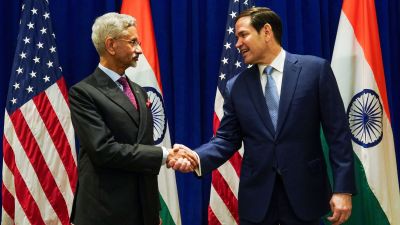Text, styles and videotape
Extracting literature from the pages of books and putting it onto video cassettes to be broadcast all over the state is no mean task. Especi...

Extracting literature from the pages of books and putting it onto video cassettes to be broadcast all over the state is no mean task. Especially when this transition of medium must take care to preserve the essence of the works and their style.
Accomplishing just that is the talented team of Bars & Tone Television (Pvt) Ltd (B&T), a local video production company. All its members – S S Sardesai, Vijendra Patil, Atul Tamhankar, Sanjay Dabke, Dharmendra Chavan and Girish Kemkar – along with their associates, have been involved in this prestigious venture, a three-episode-project on Marathi literature for Doordarshan, to be aired on April 27, May 4 and May 11.
These three episodes form part of a 52-episode serial, Swatantryachi Mandire, already being telecast since August 15 last year. To commemorate 50 years of Indian independence, every state had been commissioned by Doordarshan to prepare a serial on its achievements over the past half century, and to trace its progress in diverse fields. Accordingly, Swantantryachi Mandire went on air in Maharashtra with episodes on a range of subjects including science and technology, environment, social development, industry, ecology, cinema, television.
The team at B&T chose the subject of Marathi literature, and set to work. After five months of work – research, conceptualisation, production, post-production – involving over a 100 people in different capacities, the episodes are ready.
As envisaged by the producers, the aim here is not to record a chronology of Marathi literature. Instead, the attempt is to concentrate on the milestones in this journey. Says Sanjay Dabke, a B&T director, “The audio-visual medium has its restrictions, time being the primary constraint. We could not cram all the major personalities and the major works into these episodes of 27 minutes each. We had to shortlist, and our guiding parameter was the period when these (renowned) writers flourished. We had five decades to cover but only three episodes on hand.”
Accordingly, the first episode, Marathi Sahityatil Suvarnayug, focuses on three eminent writers – N S Phadke, V S Khandekar and Acharya Atre – who are no more. The next, Marathi Kathavishwa, is an amalgamation of the past and the present, in the sense that the writers – Gangadhar Gadgil and Venkatesh Madgulkar – wrote a long time ago, but are alive to talk about it today. And the last one, Marathi Kadambaritil Stree Vyaktirekha, draws literary heroines from the last 100 years, and relates them to contemporary times. From the past we arrive into the present.
The first capsule, directed by Ram Gabale and supplemented with Santosh Kolhe’s background research, employs a melange of techniques to present the lives and works of this powerful triad of writers that dominated the scene for almost 25 years from 1940. Dealt with individually, three anchorpersons – Veena Dev, Shaila Mukund and D M Mirasdar – reacquaint the audience with their texts, their literary skills and their distinct treatment of themes that superbly captured the nuances of human life, as experienced by people then.
“This is not a critical analysis of their works, but we do try to examine their individual styles and the common traits that can be detected in the bulk of their writings.”
To sustain the viewer’s interest and prevent it from becoming tediously theoretical, the presentation moves back and forth from readings of selected passages to biographical information, family photographs and also dramatised (“not cinematic,” emphasises Dabke) renderings of the read passage.
Marathi Kathavishwa focuses on the well-known short story writers Gangadhar Gadgil and Venkatesh Madgulkar, taking them as representatives of the exponents of this genre. The specific styles of these two litterateurs, whose careers ran almost simultaneously (but whose themes depicted lifestyles as different as urban from rural) set the trend for many to follow. Directed by Ajit Satbhai, this episode also makes use of readings, theatric portrayals, observations by other writers and analysts to enlighten the viewers with their literary status.
“More importantly, the two writers themselves appear on screen, reading and talking about their works, and for their ardent readers, this is a never-before-kind of opportunity,” says Dabke.
The third in this series, with the self-explanatory title Marathi Kadambaritil Stree Vyaktirekha, is directed by Nandan Kudhyadi and scheduled for May 11. Experimenting with this theme, the team worked out its hypothesis in detail. Selecting landmark novels, stories from the last 100 years, the female protagonists are the focus of attention – their personalities, their mental make-up, changes in their characterisation over the years which have direct bearing on the changing persona of the Maharashtrian woman. Linking these prototypes to form a chain is the sutradhar, Nandu Madhav.
“Each of the three directors has his unique way of handling a topic, and that is what we have tapped,” says Dabke. “The music for all has been composed by Ajit Soman, the melodies apt for the particular era. With only three episodes at our disposal, we had to be focussed in what we had to say.
Poetry could not be accommodated. We could put across just this much,” and undoubtedly, they have put it across very well.
Photos


- 01
- 02
- 03
- 04
- 05





























